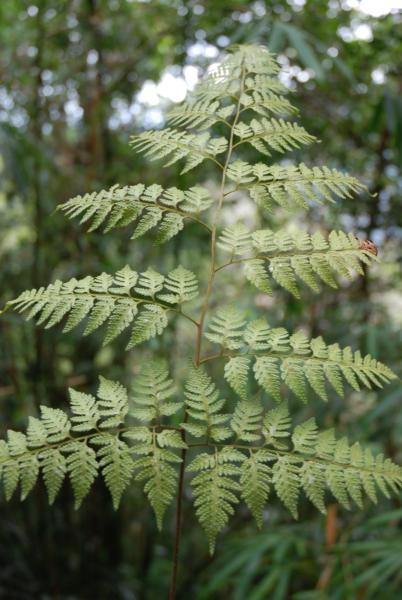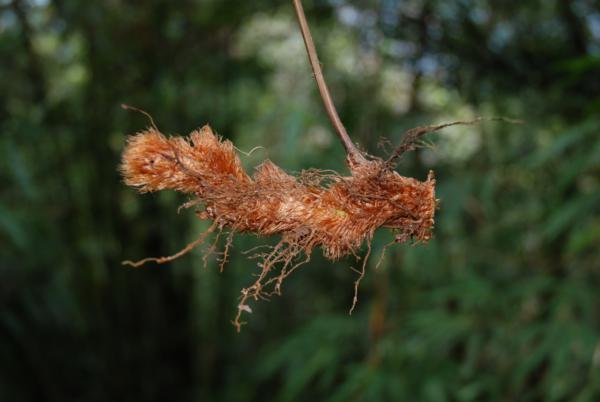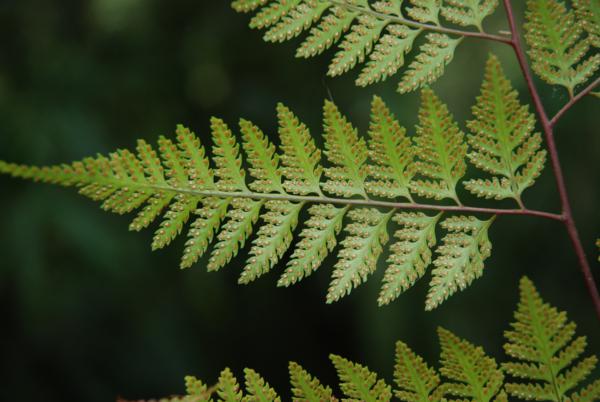
Davallia divaricata Blume
Family
Davalliaceae
Nomenclature
Davallia divaricata Blume, Enum. Pl. Javae: 237. 1828; Bedd., Handb. Ferns Brit. India: 60. 1883; Tardieu & C.Chr., Fl. Indo-Chine 7(2): 107. 1939; Holttum, Rev. Fl. Malaya ed. 1, 2: 362, f. 209. 1955 [‘1954’]; Holttum, Dansk Bot. Ark. 23: 234. 1965; Tagawa & K.Iwats., SouthE. Asian Stud. 5: 76. 1967; Tagawa & K.Iwats., Fl. Thailand 3: 161. 1985; Nooteboom, Fl. Males., Ser. II, Ferns and Fern Allies 3: 252. 1998; Boonkerd & Pollawatn, Pterid. Thailand: 233. 2000. – Araiostegia divaricata (Blume) Kato, Acta Phytotax. Geobot. 26: 158. 1975. – Wibelia divaricata (Blume) M.Kato & Tsutsumi, Acta Phytotax. Geobot. 59(1): 13. 2008. – Type: Blume s.n. (L sheet 908.333-153 holo; K), Java, G. Burangan.
Davallia orientalis C.Chr., Bull. Dept. Biol. Sun Yatsen Univ. 3: 104, t. 43. 1932. – Davallia divaricata var. orientalis (C.Chr.) Tardieu & C.Chr., Notul. Syst. (Paris) 6: 3, pl.1, 3-4. 1937; Tardieu & C.Chr., Fl. Indo-Chine 7(2): 107. 1939.
Description
Rhizome creeping, thick, usually more than 8 mm diam., densely scaly throughout; scales linear-lanceolate, gradually narrowing towards long-tailed apex, up to 15 by 2 mm, entire, minutely toothed, brown, orange-brown or pale brown. Stipes castaneous to darker, up to 50(–60) cm long, terete, minutely scaly, Laminae oblong, acuminate at apex, quadripinnate to quadripinnatifid, less divided in sterile fronds, up to 80(–100) by 65(70) cm; all pinnae anadromous; basal pinnae the largest, narrowly deltoid, broadly cuneate at base, stalked, up to 40 by 30 cm; pinnules gradually narrowing from base to long caudate-acuminate apex, unequally cuneate at base, stalked; ultimate segments round to moderately acute, with acute entire lobes, subcoriaceous, glabrous; veins pinnate, without false veinlets. Sori small, terminal on veinlets, the edges 0.2–0.4 mm inside the margin of lobes, more or less sunken, appearing prominent on upper surface; indusia cup-shaped, up to 1.2 mm long, 0.7 mm diam.
Distribution in Thailand
EASTERN: Buri Ram; CENTRAL: Nakhon Nayok; PENINSULAR: Surat Thani, Krabi, Nakhon Si Thammarat, Trang, Yala.
Distribution in Laos
Salavan.
Distribution in Cambodia
Kampot, Kompong Speu
Wider Distribution
Burma, S China, Indochina, Hainan, Taiwan, Peninsular Malaysia, Sumatra, Java and New Guinea.
Ecology
On mossy tree trunks or on rocks near streams in light shade or in clearing and on ridge and at low or medium altitudes.
Proposed IUCN Conservation Assessment
Least Concern (LC). This species is widespread and not under any known threat.
Voucher specimens - Thailand
Middleton et al. 4416, Nakhon Si Thammarat, Namtok Yong National Park (E).
Voucher specimens - Laos
Poilane 16152, Salavan, Pou Set (P).
Voucher specimens - Cambodia
Pierre 5770, Kampot, Kamchay (P);Pierre 5773, Kompong Speu (P).
Frond
Rhizome
Pinna
Site hosted by the Royal Botanic Garden Edinburgh. Content managed by Stuart Lindsay, Gardens by the Bay, Singapore and David Middleton, Singapore Botanic Gardens. Last updated 24 January 2012


